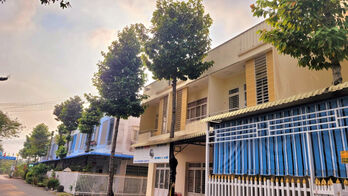.png)
Urbanization and urban development have become important driving forces to promote the province's socio-economic development (In photo: Tan An City) (Photo: Huynh Du)
Urban development orientation
Long An is the only province of the Mekong Delta region that borders Ho Chi Minh City and the Southeast region on the mainland. Currently, the province has 15 district-level administrative units (13 districts, 1 town, 1 city). The province has 19 urban areas, including: 1 class II urban area (Tan An city), 1 class III urban area (Kien Tuong town), 5 class IV urban areas (Hau Nghia, Ben Luc, Can Duoc, Can Giuoc, Duc Hoa towns) and 12 class V urban areas (Tan Hung, Vinh Hung, Tan Thanh, Thanh Hoa, Thu Thua, Tan Tru, Tam Vu, Dong Thanh, Hiep Hoa, Binh Phong Thanh towns, Rach Kien and Long Duc Dong urban areas).
.jpg)
Kien Tuong town, located in the west of the province, is oriented to be border urban area (In photo: Kien Tuong town) (Photo: Tuan Hung)
Ben Luc district is adjacent to Ho Chi Minh City, in the key economic region of the province. According to Chairman of Ben Luc District People's Committee - Le Thanh Ut, in the planning, the district is determined to have an important geographical location, being a satellite urban area of the gateway to Ho Chi Minh City and a to the provinces of Mekong Delta region. The district is striving to become a class IV urban area by 2025, a class III urban area under the province by 2030, and a class II by 2045.
In particular, the district focuses on developing industry, urban areas, trade and services in a smart and modern direction; Technical infrastructure such as transportation, water supply and drainage, electricity supply are increasingly developing in sync with social infrastructure such as hospitals, schools, culture, physical training - sports, entertainment, etc, improving people's material and spiritual lives.
Ben Luc district is focusing on a general planning for urban construction until 2045, and sending to the Ministry of Construction for appraisal. According to the Master Plan for Socio-Economic Development of Long An province for the period 2021-2030, with a vision to 2050, Ben Luc is oriented to develop industry - urban - trade - integrated services, creating Ben Luc - Tan An central urban development corridor.
Accordingly, for the southern area of Ben Luc urban area, 3,261 hectares of residential land have been allocated, of which, there are a number of projects that the Provincial People's Committee has approved to survey, sponsor planning and organize bidding, etc. The northern area of Ben Luc is oriented to develop ecological and industrial urban areas suitable for developing industrial parks by 2030; in which, land for the urban area is 3,133 hectares.
The western area of Vam Co Dong river of Ben Luc urban area is oriented to be industry - ecological urban areas, with high-tech agriculture such as smart ecological urban areas and ecological urban complexes, resorts urban areas, etc.
.jpg)
According to the orientation, by 2030, Can Giuoc City will be established under the province (Photo: Thanh Nga)
Like Ben Luc, Can Giuoc is a key district for socio-economic development of the province with a location adjacent to Ho Chi Minh City and a convenient transportation system. Can Giuoc district currently has 14 communes and 1 town. The entire district has 2 urban areas (1 type IV urban area, Can Giuoc town, recognized in 2015, and 1 type V urban area, Long Duc Dong urban area). Since 2017, the district has been planned to become a southern satellite urban area, a place to receive the expansion in all aspects of Ho Chi Minh City.
The province is implementing Action Program No. 21, dated August 19, 2022 of the Provincial Party Standing Committee to implement Resolution No. 06, dated January 24, 2022 of the Politburo on planning, building, managing and sustainably developing urban areas in Vietnam until 2030, with a vision to 2045 in Long An province, in which, determining that Can Giuoc district will meet class III urban standards. With the province's orientation, Can Giuoc district is determined to form Can Giuoc urban area throughout the district by 2025 (at grade III urban level), and by 2030, Can Giuoc city will be established under the province.
Driving force for economic development
Besides the results, the province's urban development in recent times has had limitations, difficulties and problems. The urbanization rate is still low compared to the national average. Although the appearance of urban areas has improved, it has not yet achieved prominence and having its unique identity. In the coming time, the province will continue to improve the quality of urban planning projects through organizing the preparation, appraisal and approval of planning. At the same time, the province is building and developing smart cities with high connectivity, sustainable and effective development.
In particular, the provincial government considers the people as the center, based on the actual needs of the people, making all people enjoy the fruits of urban construction. In addition, the province continues to invest in developing a synchronous, modern, interconnected urban infrastructure system, adapting to climate change, protecting the environment, ensuring security and national defense; building a transportation network linking urban areas throughout the province and connecting well with Ho Chi Minh City and neighboring provinces.
The province also promotes administrative reform and applies new technology to urban management and development, becoming an important driving force in promoting socio-economic development; propagatés and mobilizes deeply and widely throughout society about the position, role and importance of planning, construction, management and sustainable urban development in the process of industrialization and modernization./.
By Gia Han - Translated by Q. Thien
Source: https://baolongan.vn/phat-trien-do-thi-tro-thanh-dong-luc-thuc-day-phat-trien-kinh-te-xa-hoi-a165944.html

.png)
.jpg)
.jpg)


